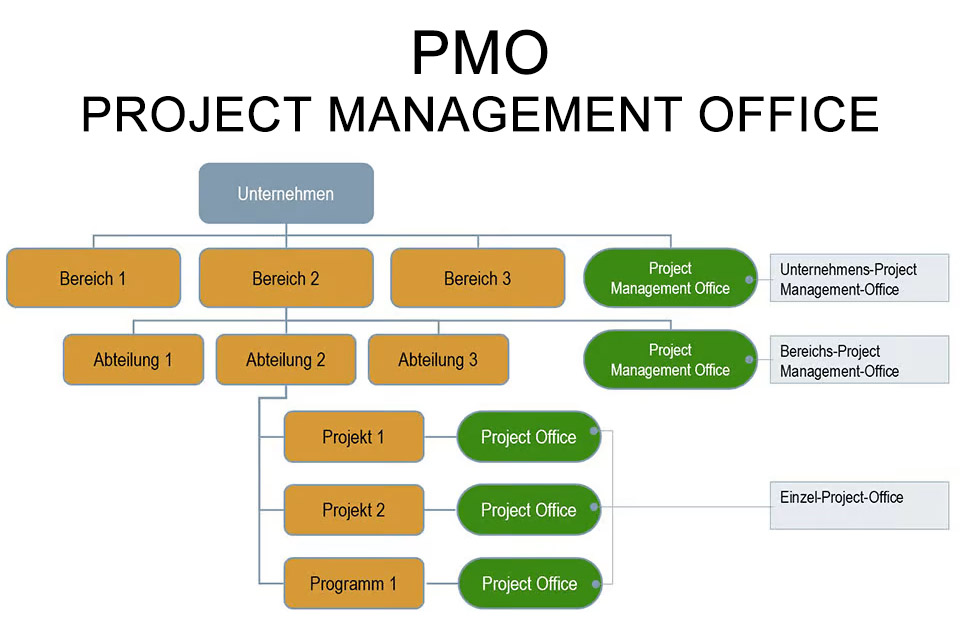What is a PMO?
Smartpedia: A project management office (PMO) is a permanent function in project management that performs supportive tasks for projects.
PMO Definition
PMO is an acronym and stands for Project Management Office. Since the German translation “Projektleitstelle” or “Projektmanagementbüro” are used relatively rarely or almost never, the English term is also established in German-speaking countries. A PMO is a permanent function in project management that performs supporting and accompanying tasks for projects.
In DIN 69901-5, a PMO is described as follows: “Cross-project support function for the introduction and optimisation of project management systems as well as the operational support of projects and project participants.”
This is distinguished from so-called POs (Project Offices), whose responsibility is limited to a single project, sometimes a programme. A PO is a “function assigned to a single project that provides support services to the project”. And it is a temporary facility.
PMO tasks
A PMO has a wide range of tasks. The exact scope depends on the requirements of the area for which it is active and on the cultural parameters in the organisation. Essentially, these are the following tasks:
- Development and definition of methods, processes, tools, best practices and templates (also company and/or division level) and thus the determination of standards and guidelines
- multi-project reporting,
- project portfolio management,
- resource management,
- overall quality and risk management,
- provision of project managers,
- provision of services for individual projects, including kick-off meetings, project controlling,
- coaching of project managers,
- educational offers in project management,
- establishment and ongoing development of a PM community,
- shaping a PM career.
In addition, there are also Project Management Offices that perform organisation-specific governance tasks or support activities. In some PMOs, both are represented, although in such cases it is advisable not to fill contradictory roles with one and the same person.
Reasons for introducing and using a PMO
There are a number of reasons why organisations decide to use Project Management Offices:
- They want to establish and live a uniform project concept within the company and avoid so-called submarine projects.
- They want to increase the competencies of the employees involved in projects and thus, for example, reduce the number of failed projects.
- They want to actively benefit from the lessons learned from other projects.
- They want to know which employees are active in which projects.
- They want to reduce the costs per project and increase productivity.
- You want to ensure consistent, high quality in projects and, if applicable, increase the maturity of the organisation.
- They want to improve the alignment of projects with regard to defined corporate goals.
- They want to use standardised processes, workflows, methods, etc. to improve the overall implementation of projects.
- They want to use standardised tools to minimise set-up time in projects and maximise efficiency.
- They want to define uniform reports to promote comparability of projects and gain insights for the selection of future projects.
- They want to make project progress more transparent for stakeholders. (“Typical” stakeholders are company management, project managers, project staff, PMO staff, supervisors of project staff, customers and project clients).
And last but not least: organisations use Project Management Offices to complete more projects on time and in budget (or better: under budget).
The benefits of a PMO can also be derived from the reasons for introducing and using it: Maximising success, more efficiency, lower costs, fewer errors, better allocation of resources, minimising project risks, increasing the maturity level, etc.
Questions to ask when introducing the PMO
There are a number of questions that organisations should ideally answer when introducing Project Management Offices:
- Why do you want to introduce a PMO in the first place? What benefits – e.g. strategic orientation and successful design of projects, satisfaction of stakeholders, maximisation of project throughput, optimisation of resource allocation, safeguarding of investments, increase of project management maturity level – are you aiming for?
- What is the current situation in the organisation? Where are there challenges, for example, in terms of scheduling and cost planning, dealing with changes, the qualifications of the project management or project staff, the prioritisation of tasks, etc.)?
- Who are the specific stakeholders and what are their expectations and goals? Where are the possible conflicts of objectives? Stakeholder identification and analysis should provide answers to these questions.
- Which sphere of influence do you want to address (R&D, IT or sales, marketing, HR)?
- Which specific tasks should be taken on at the beginning and in the course of time? What is the mission to be fulfilled? How do you communicate the mission to the organisation and to the stakeholders?
- How and in which forms (meetings) will there be a continuous, regular exchange with all those involved and stakeholders? (In practice, it is often advisable to agree on different jour fixes).
- How and where do you record the project list, as well as corresponding project assignments and status reports? (In practice, it is recommended – at least over time – to maintain and update this information centrally and with dedicated tools).
- What will the ideal PMO look like in the future?
And last but not least: How do you recognise the success of the Project Management Office?
PMO performance measurement
Measuring the success of a Project Management Office is a special challenge for every PMO leadership. Ideally, the findings will help in the management and enhancement of operational project support. Many organisations are looking for parameters that reflect the success or failure of PMOs. They demand business cases as a basis for projects and define key performance indicators (KPI), they try to attribute project successes proportionately to the Project Management Office or use benchmarks. Due to the uniqueness and diversity of projects, this is not trivial and can be doubted. “Malicious tongues” therefore claim that proving the actual added value of a PMO is one of the biggest challenges in project management.
Some publications refer to strategic, project monitoring and operational project management offices. Does such a distinction make sense in practice?
Notes (some in German):
If you like the article or would like to discuss it, please feel free to share it in your network. And if you have any comments, please do not hesitate to send us a message.
[1] Das PMO in der Praxis – GPM Studie
Here you will find additional information from our t2informatk Blog:




